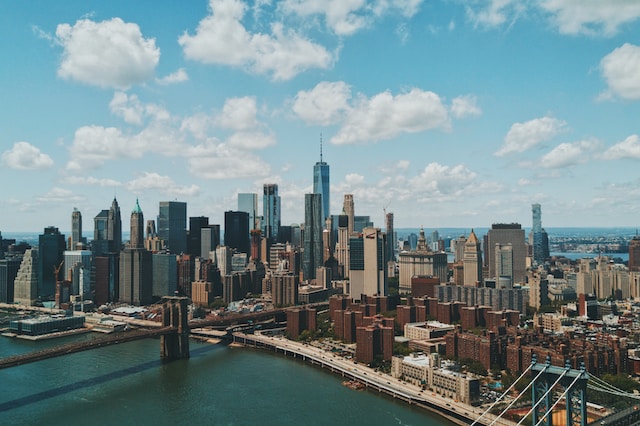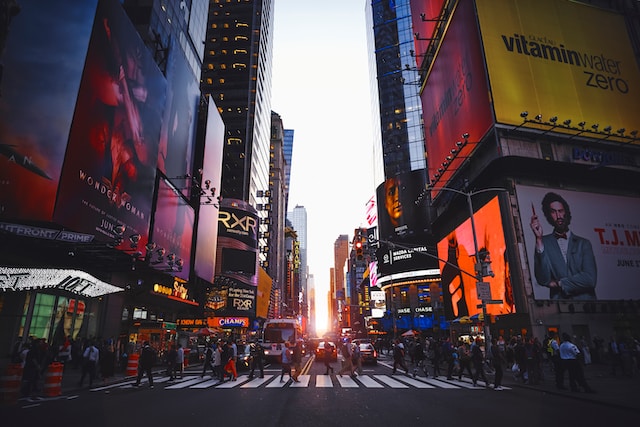When considering a move to a new city, the comparison between Seattle and New York City often comes to mind.
Both cities offer unique opportunities and experiences, but they also have distinct differences that can significantly impact your lifestyle, career, and overall well-being.
In this comprehensive report on “Seattle vs. New York City,” we’ll explore key aspects such as cost of living, crime and safety, career and employment, education, and weather and climate.
Quick Snapshot of Seattle vs. New York City
| Categories | Seattle | New York City |
|---|---|---|
| Cost of Living | Generally lower, no state income tax | Higher, especially in housing |
| Crime & Safety | Higher crime rates | Lower crime rates |
| Career & Employment | Higher average salary, lower unemployment | Lower average salary, higher unemployment |
| Education | Higher public school graduation rate | Highly-ranked universities |
| Weather & Climate | Milder, more temperate | Colder winters, hotter summers |
1. Cost of Living
Understanding the cost of living is crucial for anyone considering a move, as it directly impacts the quality of life and financial stability.
Here’s a closer look at the cost of living differences between Seattle and New York City:
Avg. Cost of 1 Bed Room Rent
| Seattle | New York City |
| $1,995/month | $3,995/month |
Seattle’s average 1-bedroom rent of $1,995/month is almost half of New York City’s $3,995/month. For singles or couples considering a move, this significant difference can be a game-changer.
If you’re looking to live alone or with a partner and want to save on housing, Seattle’s more affordable rent may align with your financial goals.
It could allow for more disposable income, savings, or spending on other lifestyle preferences.
Avg. Cost 2 Bed Room Rent

| Seattle | New York City |
| $2,768/month | $4,495/month |
Families or those needing more space will find Seattle’s 2-bedroom rent of $2,768/month more budget-friendly compared to New York City’s $4,495/month.
If you have children or plan to share space with roommates, this difference can translate into substantial annual savings.
It may enable you to live in a more desirable neighborhood, invest in furnishings, or save for future needs like education or travel.
Avg. Cost of A House
| Seattle | New York City |
| $823,900 | $799,000 |
Interestingly, Seattle’s average house cost is higher at $823,900 compared to New York City’s $799,000.
If you’re considering buying a home, this difference may reflect variations in housing availability, neighborhood desirability, or property sizes.
If you’re looking to purchase in a more prime neighborhood, the median house listing in Manhattan is $1,595,000.
It’s essential to explore specific areas, types of homes, and local real estate trends to understand what this price difference means for your home-buying experience in either city.
Income Tax
| Seattle | New York City |
| No state income tax | 3.078% – 3.876% |
Seattle’s lack of state income tax contrasts sharply with New York City’s income tax, ranging from 3.078% to 3.876% depending on the tax bracket.
If you’re a working professional, this difference can lead to significant annual savings in Seattle.
It may allow for more flexible spending, investment, or retirement planning, especially if you fall into a higher tax bracket.
🏙️ See these 20 pros & cons about living in Seattle
Property Tax
| Seattle | New York City |
| 1.025% | 14% |
Seattle’s property tax rate of 1.025% is much lower than New York City’s 14%.
If you’re planning to buy a home, this disparity can greatly affect annual housing costs and may influence your home buying decisions.
Lower property taxes in Seattle may enable you to afford a larger or better-located property, or simply reduce your overall housing expenses.
Sales Tax
| Seattle | New York City |
| 10.25% | 8% |
Seattle’s sales tax of 10.25% is higher than New York City’s total rate of 8%.
If you’re a frequent shopper or conscious of daily expenses, this difference may impact your shopping habits and overall spending.
It could influence decisions on large purchases, dining out, or entertainment, and may require budget adjustments to accommodate the higher sales tax in Seattle.
Minimum Grocery Bill per Month
| Seattle | New York City |
| $502.82/month recommended minimum | $559.35/month recommended minimum |
The recommended minimum grocery bill in Seattle is $502.82/month, slightly lower than New York City’s $559.35/month.
If you cook at home often or have specific dietary needs, this difference may reflect variations in food availability, preferences, or shopping habits.
Understanding local grocery costs can help you plan your monthly budget and make informed choices about where and how to shop.
Average Healthcare Costs
| Seattle | New York City |
| $5040/year for a single adult | $5808/year for a single adult |
Healthcare costs for common services like doctor’s and dentist’s visits are provided for Seattle but not for New York City.
If healthcare is a priority for you or your family, Seattle’s costs may serve as a baseline, but local research may be needed for a more accurate comparison in New York City.
Consider factors like insurance coverage, healthcare provider networks, and specific medical needs to assess how these costs align with your healthcare priorities and budget.
2. Crime & Safety

Safety is a paramount concern for residents, and understanding crime rates and response times can provide valuable insights:
Overall Crime Rate
| Seattle | New York City |
| 63.5 per 1,000 people | 24.83 per 1,000 people |
Seattle’s overall crime rate of 63 per 1,000 people is significantly higher than New York City’s 24.83 per 1,000 people. The overall crime rate in Seattle is higher than the national average.
If safety is a top priority for you, this stark difference may heavily influence your perceptions of safety and neighborhood choices.
Living in an area with a lower crime rate like New York City may provide peace of mind, especially if you have children or are concerned about personal security.
It may also affect your daily routines, social activities, and transportation choices.
Violent Crime Rate
| Seattle | New York City |
| 8.02 per 1,000 people | 5.21 per 100,000 people |
Similarly, Seattle’s violent crime rate of 8.02 per 1,000 people is much lower than New York City’s 5.21 per 100,000 people.
If you are particularly concerned about violent crime, this difference may be a critical consideration in your decision-making process.
Families or individuals prioritizing personal safety may find New York’s lower violent crime rate more appealing.
It may also influence decisions about outdoor activities, evening outings, or public transportation usage.
Property Crime Rate
| Seattle | New York City |
| 55.47 per 1,000 people | 19.62 per 100,000 people |
Property crime rates also differ substantially, with Seattle at 55.47 per 1,000 people and New York City at 19.62 per 1,000 people.
If you own valuable property or are concerned about theft or vandalism, this difference may affect decisions related to housing security and insurance.
Living in New York City may allow for more relaxed security measures, potentially reducing stress and expenses related to property protection.
It may also influence choices about vehicle ownership, bicycle storage, or home security systems.
Police Response Time
| Seattle | New York City |
| 10 Minutes | 8.5 Minutes |
Both cities have comparable police response times, with Seattle at 10 minutes and New York City at 8.5 minutes.
If you value prompt emergency response, this similarity suggests a similar level of police efficiency and readiness in both cities.
It may provide reassurance that help is readily available in urgent situations, regardless of whether you choose Seattle or New York City.
This factor may be particularly relevant if you live alone, have specific security concerns, or are involved in community safety initiatives.
Ambulance Response Time
| Seattle | New York City |
| 11 Minutes | 9.5 Minutes |
Ambulance response times are also similar, with Seattle at 11 minutes and New York City at 9.5 minutes.
If healthcare accessibility and emergency medical services are important to you, this reflects comparable services in both cities.
It may provide confidence that medical assistance is quickly available in case of accidents, sudden illnesses, or other emergencies.
This factor may be especially relevant for individuals with chronic health conditions, elderly family members, or young children.
3. Career & Employment

Career opportunities and employment conditions are vital factors for working professionals. This is especially true for cities that come with a heftier price tag.
Average Annual Salary
| Seattle | New York City |
| $75,569/year | $50,761/year |
Seattle’s average annual salary of $75,569 is significantly higher than New York City’s $50,761.
If you’re a working professional considering a move, this difference may be a major factor in your decision-making process.
Higher salaries in Seattle may attract professionals in certain industries, such as technology or finance, where the city has a strong presence.
Even with the higher cost of living in New York City, the potential for a higher salary in Seattle may allow for a more comfortable lifestyle, increased savings, or investment in personal or professional development.
It may also influence decisions about career advancement, industry focus, or work-life balance.
Minimum Wage
| Seattle | New York City |
| $18.69/hr | $15/hr |
Seattle’s minimum wage of $18.69/hr is higher than New York City’s $15/hr.
If you’re an entry-level worker, part-time employee, or someone earning minimum wage, this difference may have a significant impact on your quality of life.
A higher minimum wage in Seattle may benefit lower-wage workers by providing more disposable income, better financial stability, or the ability to work fewer hours for the same income.
It may also influence decisions about education, skill development, or career progression, offering a more supportive environment for personal and professional growth.
Unemployment Rate
| Seattle | New York City |
| 3.4% | 5.3% |
Seattle’s unemployment rate of 3.4% is lower than New York City’s 5.3%.
If job security and availability are top priorities for you, this difference may reflect variations in local economies, industries, and job availability that are worth considering.
A lower unemployment rate in Seattle may indicate a more robust job market, with more opportunities in certain sectors or roles. It may also suggest a more competitive environment, requiring specific skills, experience, or networking efforts.
Understanding the local job market, industry trends, and employment resources in both cities can help you align your career goals, job search strategies, and professional development plans with the opportunities and challenges unique to Seattle or New York City.
🌆 See how Seattle fairs versus San Francisco!
4. Education

Education is a key consideration for families and students, and differences in university rankings and graduation rates can be influential:
University Rankings
| University of Washington | New York City |
| #29 in US | #26 in US |
Both cities boast highly-ranked universities, with the University of Washington at #29 in the US and universities in New York City collectively ranking at #26.
If you’re an aspiring college student or a parent of one, this similarity may be a significant factor in your decision-making process.
High-ranking universities often offer prestigious educational opportunities, research facilities, faculty expertise, and networking connections.
Whether you’re pursuing undergraduate or graduate studies, the presence of top-ranked universities in both Seattle and New York City may provide access to quality education, specialized programs, and career development resources.
It may also influence decisions about academic focus, extracurricular involvement, or study abroad experiences, contributing to a rich and fulfilling educational journey.
Graduation Rates
| Seattle | New York City |
| 86% | 81% |
Seattle’s public school graduation rate of 86% is slightly higher than New York City’s 81%. If you have school-aged children or are involved in education, this difference may be an important consideration.
Higher graduation rates may reflect variations in educational quality, resources, teacher support, and community engagement.
It could indicate a more supportive learning environment, better student outcomes, or more effective educational policies in Seattle.
Understanding the specific factors contributing to these graduation rates, such as class sizes, curriculum standards, parental involvement, or special education services, can help you align your educational choices with your children’s needs, interests, and goals.
It may also guide your involvement in school activities, parent-teacher relationships, or educational advocacy efforts, ensuring a positive and successful educational experience for your family.
5. Weather and Climate

Weather and climate can greatly affect daily life and outdoor activities. Seattle is well known for its plentiful amount of outdoor recreational opportunities, but rainy weather.
Whereas the Big Apple is no doubt the epitome of a concrete jungle and more extreme weather!
Average Temperature
| Season | Seattle | New York City |
| Fall | 45°F – 58°F | 38°F – 80°F |
| Winter | 40°F – 50°F | 26°F – 49°F |
| Spring | 53°F – 69°F | 34°F – 69°F |
| Summer | 69°F – 75°F | 68°F – 90°F |
Seattle offers a more temperate climate, with milder winters and cooler summers. In contrast, New York City experiences cold winters and hot summers, with a broader temperature range.
If you’re sensitive to extreme temperatures or have specific outdoor interests, this difference may be a significant consideration.
Seattle’s milder climate may be appealing for those who prefer moderate temperatures, enjoy outdoor activities year-round, or have health concerns related to heat or cold.
New York City’s more varied temperature range may offer distinct seasonal experiences, from snowy winters to hot beach days.
Understanding how these temperature differences align with your lifestyle, hobbies, wardrobe, or energy consumption can help you make informed decisions that enhance your comfort, well-being, and enjoyment of daily life.
Weather Characteristics
| Seattle | New York City |
| mild temperatures, considerable cloudiness, and a pronounced rainy season | cold winters and hot summers, with abundant precipitation and an unstable climate |
Seattle is known for its mild temperatures, considerable cloudiness, and pronounced rainy season, while New York City has a more unstable climate with abundant precipitation.
These differences offer distinct experiences for outdoor enthusiasts and may influence lifestyle preferences. If you enjoy outdoor activities like hiking, biking, or gardening, Seattle’s consistent rain and cloud cover may require specific gear, planning, or adaptations.
New York City’s more varied weather may offer more diverse outdoor opportunities but also more unpredictable conditions.
These weather characteristics may also influence decisions about housing, transportation, social activities, or health routines. For example, Seattle’s rainy season may encourage indoor hobbies, public transportation usage, or specific landscaping choices.
New York City’s fluctuating weather may require more flexible planning, weatherproofing measures, or seasonal social activities.
The comparison between Seattle and New York City reveals a complex landscape of contrasts and similarities.
From the significant differences in cost of living and crime rates to the more nuanced variations in education and weather, the choice between Seattle and New York City depends on individual priorities, values, and lifestyle preferences.
Now if you’ve decided to head to Seattle, you’ll want to consider eating at the best restaurants and visiting checking out these city tours!
Sources:
Cost of Living: [1], [2]. [3]. [4]. [5], [6], [7], [8], [9]
Crime: [1], [2], [3], [4], [5], [6]
Career & Employment: [1], [2], [3], [4], [5]
Education: [1]. [2], [3]
